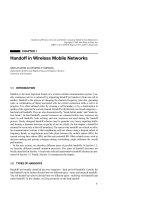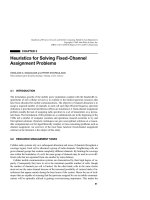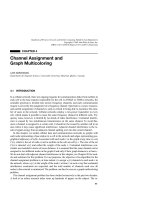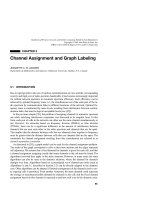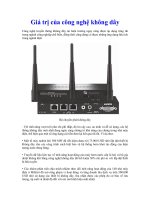Tài liệu Sổ tay của các mạng không dây và điện toán di động P10 doc
Bạn đang xem bản rút gọn của tài liệu. Xem và tải ngay bản đầy đủ của tài liệu tại đây (165.57 KB, 24 trang )
CHAPTER 10
Leader Election Protocols
for Radio Networks
KOJI NAKANO
Japan Advanced Institute for Science and Technology
STEPHAN OLARIU
Department of Computer Science, Old Dominion University, Norfolk
10.1 INTRODUCTION
A radio network (RN, for short) is a distributed system with no central arbiter, consisting of
n radio transceivers, henceforth referred to as stations. In a single-channel RN, the stations
communicate over a unique radio frequency channel known to all the stations. A RN is said
to be single-hop when all the stations are within transmission range of each other. In this
chapter, we focus on single-channel, single-hop radio networks. Single-hop radio networks
are the basic ingredients from which larger, multi-hop radio networks are built [3, 22].
As customary, time is assumed to be slotted and all transmissions are edge-triggered,
that is, they take place at time slot boundaries [3, 5]. In a time slot, a station can transmit
and/or listen to the channel. We assume that the stations have a local clock that keeps syn-
chronous time, perhaps by interfacing with a global positioning system (GPS, for short)
[6, 8, 18, 20]. It is worth noting that, under current technology, the commercially available
GPS systems provide location information accurate to within 22 meters as well as time in-
formation accurate to within 100 nanoseconds [6]. It is well documented that GPS sys-
tems using military codes achieve a level of accuracy that is orders of magnitude better
than their commercial counterparts [6, 8]. In particular, this allows the stations to detect
time slot boundaries and, thus, to synchronize.
Radio transmission is isotropic, that is, when a station is transmitting, all the stations in
its communication range receive the packet. We note here that this is in sharp contrast
with the basic point-to-point assumption in wireline networks in which a station can spec-
ify a unique destination station. We employ the commonly accepted assumption that when
two or more stations are transmitting on a channel in the same time slot, the corresponding
packets collide and are garbled beyond recognition. It is customary to distinguish among
radio networks in terms of their collision detection capabilities. In the RN with collision
detection, the status of a radio channel in a time slot is:
NULL if no station transmitted in the current time slot
SINGLE if exactly one station transmitted in the current time slot
219
Handbook of Wireless Networks and Mobile Computing, Edited by Ivan Stojmenovic´
Copyright © 2002 John Wiley & Sons, Inc.
ISBNs: 0-471-41902-8 (Paper); 0-471-22456-1 (Electronic)
COLLISION if two or more stations transmitted the channel in the current time slot
The problem that we survey in this chapter is the classical leader election problem,
which asks the network to designate one of its stations as leader. In other words, after exe-
cuting the leader election protocol, exactly one station learns that it was elected leader,
whereas the remaining stations learn the identity of the leader. Historically, the leader
election problem has been addressed in wireline networks [1, 2, 9, 10, 21], in which each
station can specify a destination station.
The leader election problem can be studied in the following three scenarios:
Scenario 1: The number n of stations is known in advance
Scenario 2: The number n of stations is unknown, but an upper bound u on n is known
in advance
Scenario 3: Neither the number of stations nor an upper bound on this number is
known in advance
It is intuitively clear that the task of leader election is the easiest in Scenario 1 and hardest
in Scenario 3, with Scenario 2 being in between the two.
Randomized leader election protocols designed for single-channel, single-hop radio
networks work as follows. In each time slot, the stations transmit on the channel with
some probability. As we will discuss shortly, this probability may or may not be the same
for individual stations. If the status of the channel is SINGLE, the unique station that has
transmitted is declared the leader. If the status is not SINGLE, the above is repeated until,
eventually, a leader is elected. Suppose that a leader election protocol runs for t time slots
and a leader has still not been elected at that time. The history of a station up to time slot t
is captured by
The status of the channel—The status of the channel in each of the t time slots, that is,
a sequence of {NULL,COLLISION} of length t.
Transmit/not-transmit—The transmission activity of the station in each of the t time
slots, that is, a sequence of {transmit,not-transmit} of length t.
It should be clear that its history contains all the information that a station can obtain in t
time slots. From the perspective of how much of the history information is used, we iden-
tify three types of leader election protocols for single-channel, single-hop radio networks:
1. Oblivious. In time slot i, (1 Յ i), every station transmits with probability p
i
. The
probability p
i
is fixed beforehand and does not depend on the history.
2. Uniform. In time slot i (1 Յ i), all the stations transmit with the same probability p
i
.
Here p
i
is a function of the history of the status of channel in time slots 1, 2, ...,
i – 1.
3. Non-uniform:In each time slot, every station determines its transmission probabili-
ty, depending on its own history.
An oblivious leader election protocol is uniquely determined by a sequence P = ͗ p
1
,
220
LEADER ELECTION PROTOCOLS FOR RADIO NETWORKS
p
2
, ...͘ of probabilities. In time slot i (1 Յ i), every station transmits with probability p
i
. A
leader is elected if the status of the channel is SINGLE. Clearly, oblivious leader election
protocols also work for radio networks with no collision detection, in which the stations
cannot distinguish between NULL and COLLISION.
A uniform leader election protocol is uniquely determined by a binary tree T of proba-
bilities. T has nodes p
i, j
(1 Յ i; 1 Յ j Յ 2
i–1
), each corresponding to a probability. Node
p
i, j
has left child p
i+1,2 j–1
and right child p
j+1,2 j
. The leader election protocol traverses T
from the root as follows. Initially, the protocol is positioned at the root p
1,1
. If in time slot i
the protocol is positioned at node p
i, j
, then every station transmits on the channel with
probability p
i, j
. If the status of the channel is SINGLE, the unique station that has trans-
mitted becomes the leader and the protocol terminates. If the status of channel is NULL,
the protocol moves to the left child p
i+1,2 j–1
; if the status is COLLISION, the protocol
moves to the right child p
i+1,2 j
.
Similarly, a nonuniform leader election protocol is captured by a ternary tree T with
nodes p
i, j
(1 Յ i; 1 Յ j Յ 3
i–1
), each corresponding to a probability. The children of node
p
i, j
are, in left to right order, p
i+1,3j–2
, p
i+1,3j–1
, and p
i+1,3j
. Each station traverses T from the
root as follows. Initially, all the stations are positioned at the root p
1,1
. If in time slot i a
station is positioned at node p
i, j
then it transmits with probability p
i, j
. If the status of the
channel is SINGLE, the unique station that has transmitted becomes the leader and the
protocol terminates. If the status of the channel is NULL, the station moves to p
i+1,3j–2
. If
the status of channel is COLLISION, then the station moves to p
i+1,3j–1
or p
i+1,3j
depending
on whether or not is has transmitted in time slot i. Figure 10.1 illustrates the three types of
leader election protocols.
Several randomized protocols for single-channel, single-hop networks have been pre-
sented in the literature. Metcalfe and Boggs [12] presented an oblivious leader election
protocol for Scenario 1 that is guaranteed to terminate in O(1) expected time slots. Their
protocol is very simple: every station keeps transmitting on the channel with probability
1/n. When the status of channel becomes SINGLE, the unique station that has transmitted
is declared the leader. Recently, Nakano and Olariu [14] presented two nonuniform leader
election protocols for Scenario 3. The first one terminates, with probability 1 – 1/n in
O(log n) time slots. (In this chapter, log and ln are used to denote the logarithms to the
base 2 and e, respectively.) The second one terminates with probability 1 – 1/log n in
O(log log n) time slots. The main drawback of these protocols is that the “high probabili-
10.1 INTRODUCTION
221
Figure 10.1 Oblivious, uniform, and nonuniform protocols.
ty” expressed by either 1 – 1/n or 1 – 1/log n becomes meaningless for small values of n.
For example, the O(log log n) time protocol may take a very large number of time slots to
terminate. True, this only happens with probability at most 1/log n. However, when n is
small, this probability is nonnegligible. To address this shortcoming, Nakano and Olariu
[15] improved this protocol to terminate, with probability exceeding 1 – 1/f in log log n +
2.78 log f + o(log log n + log f ) time slots. Nakano and Olariu [16] also presented an
oblivious leader election protocol for Scenario 3 terminating with probability at least 1 –
1/f in O{min[(log n)
2
+ (log f )
2
, f
3/5
log n]} time slots.
In a landmark paper, Willard [22] presented a uniform leader election protocol for the
conditions of Scenario 2 terminating in log log u + O(1) expected time slots. Willard’s pro-
tocol involves two stages: the first stage, using binary search, guesses in log log u time
slots a number i (0 Յ i Յ log u), satisfying 2
i
Յ n < 2
i+1
. Once this approximation for n is
available, the second stage elects a leader in O(1) expected time slots using the protocol of
[12]. Thus, the protocol elects a leader in log log u + O(1) expected time slots. Willard
\citeWIL86 went on to improve this protocol to run under the conditions of Scenario 3 in
log log n + o(log log n) expected time slots. The first stage of the improved protocol uses
the technique presented in Bentley and Yao [4], which finds an integer i satisfying 2
i
Յ n <
2
i+1
, bypassing the need for a known upper bound u on n. More recently, Nakano and
Olariu with probability exceeding 1 – 1/f, in log log n + o(log log n) + O(log f) time slots.
Our uniform leader election features the same performance as the nonuniform leader elec-
tion protocol of [15] even though all the stations transmit with the same probability in
each time slot.
In this chapter, we survey known leader election protocols. See Table 10.1 for the char-
acteristics of these protocols.
10.2 A BRIEF REFRESHER OF PROBABILITY THEORY
The main goal of this section is to review elementary probability theory results that are
useful for analyzing the performance of our protocols. For a more detailed discussion of
background material we refer the reader to [13].
For a random variable X, E[X] denotes the expected value of X. Let X be a random
variable denoting the number of successes in n independent Bernoulli trials with para-
222
LEADER ELECTION PROTOCOLS FOR RADIO NETWORKS
TABLE 10.1 A summary of known leader election protocols
Protocol Scenario Time slots with probability 1 – 1/f Time slots, average
Oblivious 1 e ln fe
Oblivious 2 log u log fO(log u)
Oblivious 3 O[(log n)
2
+ (log f )
2
] O[(log n)
2
]
Oblivious 3 O( f
⑀
log n) O(log n)
Oblivious 3 O{min[(log n)
2
+ (log f )
2
, f
⑀
log n]} O(log n)
Uniform 3 log log n + o(log log n) + O(log f ) log log n + o(log log n)
Nonuniform 3 log log n + 2.78 log f + o(log log n + log f ) log log n + o(log log n)
meter p. It is well known that X has a binomial distribution and that for every integer r
(0 Յ r Յ n)
Pr[X = r] =
p
r
(1 – p)
n–r
Further, the expected value of X is given by
E[X] =
Α
n
r=0
r · Pr[X = r] = np
To analyze the tail of the binomial distribution, we shall make use of the following esti-
mates, commonly referred to as Chernoff bounds [13]:
Pr[X > (1 +
␦
)E[X]] <
E[X]
(0 Յ
␦
) (10.1)
Pr[X > (1 + ⑀)E[X]] < e
–(
⑀
2
/3)E[X]
(0 Յ
⑀
Յ 1) (10.2)
Pr[X < (1 –
⑀
)E[X]] < e
–(
⑀
2
/3)E[X]
(0 Յ
⑀
Յ 1) (10.3)
Let X be a random variable assuming only nonnegative values. The following inequali-
ty, known as the Markov inequality, will also be used:
Pr[X Ն c · E[X]] Յ for all c Ն 1 (10.4)
To evaluate the expected value of a random variable, we state the following lemma.
Lemma 2.1 Let X be a random variable taking a value smaller than or equal to T(F) with
probability at least F (0 Յ F Յ 1), where T is a nondecreasing function. Then, E[X] Յ ͐
0
1
T(F)dF.
Proof: Let k be any positive integer. Clearly, X is no more than T(i/k) with probability i/k
for every i (1 Յ i Յ k). Thus, the expected value of X is bounded by
E[X] Յ
Α
k
i=1
–
T
=
Α
k
i=1
T
.
As k
Ǟ ϱ
we have E[X] Յ ͐
0
1
T(F)dF. Ǣ
For later reference, we state the following corollary.
Corollary 2.2 Let X be a random variable taking a value no more than ln f with proba-
bility at least 1 – 1/f . Then, E[X] Յ 1.
i
ᎏ
k
1
ᎏ
k
i
ᎏ
k
i – 1
ᎏ
k
i
ᎏ
k
1
ᎏ
c
e
␦
ᎏᎏ
(1 +
␦
)
(1+
␦
)
n
r
10.2 A BRIEF REFRESHER OF PROBABILITY THEORY
223
Proof: Let F = 1 – 1/f and apply Lemma 2.1. We have
E[X] Յ
͵
1
0
ln dF = [F – F ln F ]
0
1
= 1
Ǣ
10.3 OBLIVIOUS LEADER ELECTION PROTOCOLS
The main goal of this section is to discuss oblivious leader election protocols for radio
networks for Scenarios 1, 2, and 3.
10.3.1 Oblivious Leader Election for Scenario 1
Let P = ͗ p
1
, p
2
, p
3
, ...͘ be an arbitrary sequence of probabilities and suppose that in time
slot i each of the n stations of the RN is transmitting on the channel with probability p
i
. If
the status of the channel is SINGLE, the unique station that has transmitted becomes the
leader. Otherwise, in time slot i + 1 every station transmits with probability p
i+1
. This is
repeated until either the sequence P is exhausted or the status of the channel is, eventually,
SINGLE. The details are spelled out in the following protocol.
Protocol Election(P)
for i ǟ 1 to |P| do
each station transmits with probability p
i
and all stations monitor the channel;
if the status of the channel is SINGLE then
the station that has transmitted becomes the leader and the protocol terminates
endfor
Clearly, since every station transmits with the same probability p
i
in time slot i, Elec-
tion(P) is oblivious for any sequence P of probabilities. Since correctness is easy to see,
we now turn to the task of evaluating the number of time slots it takes protocol Elec-
tion(P) to terminate. Let X be the random variable denoting the number of stations that
transmit in the i-th time slot. Then, the status of the channel is SINGLE with probability
Pr[X = 1] =
p
i
(1 – p
i
)
n–1
Simple calculations show that if we choose p
i
= 1/n, the probability Pr[X = 1] is maxi-
mized. In this case,
Pr[X = 1] =
1 –
n–1
>
Therefore, we choose P = ͗1/n, 1/n, 1/n, ...͘. Now, each iteration of the for loop in proto-
col Election(P = ͗1/n, 1/n, 1/n, ...͘) succeeds in electing a leader with probability ex-
ceeding 1/e. Hence, t trials fails to elect a leader with probability
1
ᎏ
e
1
ᎏ
n
n
1
1
ᎏ
F
224
LEADER ELECTION PROTOCOLS FOR RADIO NETWORKS
1 –
t
< e
–(t/e)
Let f be a parameter satisfying 1/f = e
–(t/e)
. Then, we have t = e ln f. Therefore, we have the
following lemma:
Lemma 3.1 An oblivious protocol Election (͗1/n, 1/n, 1/n, ...͘) elects a leader in e
ln f time slots with probability at least 1 – 1/f for any f Ն 1.
Note that the value of n must be known to every station in order to perform Election
(͗1/n, 1/n, 1/n, ...͘).
10.3.2 Oblivious Leader Election for Scenario 2
The main purpose of this subsection is to discuss a randomized leader election protocol
for an n-station RN under the assumption that an upper bound u of the number n of sta-
tions is known beforehand. However, the actual value of n itself is not known.
Let D
i
(1 Ն 1) be the sequence of probabilities of length i defined as
D
i
=
͗
, , ...,
͘
We propose to investigate the behavior of protocol Election when run with the se-
quence D
i
. Can we expect Election(D
i
) to terminate with the election of a leader? The
answer is given by the following result.
Lemma 3.2 For every n, protocol Election(D
i
) succeeds in electing a leader with
probability at least 1–2 whenever i Ն log n.
Proof: The proof for n = 2, 3, 4 is easy. For example, if n = 3, Election(D
2
) fails to
elect a leader with probability
΄
1 –
1 –
2
1
΅΄
1 –
1 –
2
1
΅
= <
Hence, Election(D
2
) elects a leader with probability exceeding
1
–
2
for n = 3. The
reader should have no difficulty to confirm for n = 2 and 4. Next, assume that n > 4 and let
j = log n. Clearly, i Ն j Ն 3 and thus sequence D
i
includes 1/2
j–2
, 1/2
j–1
, and 1/2
j
.
Election(͗1/2
j–2
͘) succeeds in electing a leader with probability
1 –
n–1
> e
–n/2
j–2
΄
from
1 –
x–1
> e
–1
for every x Ն 2
΅
> e
–1/4
΄
from >
΅
.
1
ᎏ
4
n
ᎏ
2
j–2
1
ᎏ
4
1
ᎏ
x
n
ᎏ
2
j–2
1
ᎏ
2
j–2
1
ᎏ
2
j–2
n
1
1
ᎏ
2
185
ᎏ
512
1
ᎏ
4
1
ᎏ
4
3
1
1
ᎏ
2
1
ᎏ
2
3
1
1
ᎏ
2
i
1
ᎏ
2
2
1
ᎏ
2
1
1
ᎏ
e
10.3 OBLIVIOUS LEADER ELECTION PROTOCOLS
225
Similarly, we can prove that Election(͗1/2
j–1
͘) and Election(͗1/2
j
͘) succeed in
electing a leader with probability at least
1
–
2
e
–1/2
and 2e
–2
, respectively. Therefore, Elec-
tion(D
i
) fails to elect a leader with probability at most
1 – e
–1/4
1 – e
–1/2
(1 – 2e
–2
) < .
This completes the proof. Ǣ
Let D
i
ϱ
= D
i
· D
i
· D
i
· · · be an infinite sequence, where “·” denotes the concatenation
of sequences. For example, D
ϱ
2
= ͗
1
–
2
,
1
–
4
,
1
–
2
,
1
–
4
,
1
–
2
,
1
–
4
, ...͘. Suppose that every station knows the
upper bound u of the number n of the station. Since Election(D
ϱ
log u
) elects a leader
with probability at least
1
–
2
from Lemma 3.2, t times iteration of Election(D
ϱ
log u
) fails
to elect a leader with probability 1/2
t
. Also, the t times iteration runs in t log u time slots.
Therefore, we have:
Lemma 3.3 An oblivious protocol Election(D
ϱ
log u
) elects a leader in log f log u
time slots with probability at least 1 – 1/f for any f Ն 1.
10.3.3 Oblivious Leader Election for Scenario 3
Let V = ͗v(1), v(2), . . .͘ be a nondecreasing sequence of positive integers such that 1 Յ v
1
Յ v
2
Յ · · · holds. For such sequence V, let P(V) = D
v(1)
· D
v(2)
· D
v(3)
· · · be the infinite se-
quence of probabilities. For example, if V = ͗1, 2, 3, . . .͘, then P(V) = D
1
· D
2
· D
3
··· =
͗
1
–
2
,
1
–
2
,
1
–
4
,
1
–
2
,
1
–
4
,
1
–
8
, ...͘. We are going to evaluate the performance Election(P(V)) for various
sequences V.
For a sequence V = ͗v(1), v(2), . . .͘, let l(V) denote the minimum integer satisfying
v[l(V)] Ն log n. In other words
1 Յ v(1) Յ v(2) Յ ··· < v[l(V)] Յ log n Յ v[l(V) + 1] Յ v[l(V) + 2] Յ ···
holds. Notice that, from Lemma 3.2, each call of Election(D
v[l(V)]
), Election
(D
v[l(V)+1]
), ..., elects a leader with probability at least
1
–
2
. Thus, l(V) + t – 1 calls Elec-
tion(D
v(1)
), Election(D
v(2)
), ..., Election(D
v[l(V)+t]
) elect a leader with probabili-
ty at least 1/2
t
. Further, the l(V) + t – 1 calls run in v(1) + v(2)··· + v[l(V) + t – 1] time
slots. Consequently, Election(P(V)) runs in v(1) + v(2)··· + v[l(V) + log f – 1] time
slots with probability 1 – 1/f .
We conclude the following important lemma:
Lemma 3.4 For any sequence V = ͗v(1), v(2), . . .͘, Election[P(V)] elects a leader,
with probability at least 1 – 1/f for any f Ն 1 in v(1) + v(2)··· + v[l(V) + log f – 1] time
slots.
Let V
1
= ͗1, 2, 3, . . .͘ be a sequence of integers. We are going to evaluate the perfor-
mance of Election[P(V
1
)] using Lemma 3.4. Recall that
1
ᎏ
2
1
ᎏ
2
1
ᎏ
4
226
LEADER ELECTION PROTOCOLS FOR RADIO NETWORKS
P(V
1
) = D
1
· D
2
· D
3
··· = ͗
1
–
2
,
1
–
2
,
1
–
4
,
1
–
2
,
1
–
4
,
1
–
8
, ...͘
Since l(V
1
) = log n, Election(P(V
1
)) elects a leader with probability 1 – 1/f in O(1 +
2 + · · · + [log n + log f – 1)] = O[(log n)
2
+ (log f )
2
] time slots. Thus, we have the follow-
ing lemma.
Lemma 3.5 Protocol Election[P(V
1
)] elects a leader in O[(log n)
2
+ (log f)
2
] time
slots with probability at least 1 – 1/f for any f Ն 1.
For any fixed real number c (1 < c < 2) let V
c
= ͗c
0
, c
1
, c
2
, ...͘ be a sequence of
integers. Clearly, l(V
c
) Յ log log n/log c. Thus, from Lemma 3.4, Election[P(V
c
)]
elects a leader with probability 1 – 1/f in
O(c
0
+ c
1
+ · · · + c
log log n/log c + log f
) = O( f
log c
log n)
time slots. Thus we have:
Lemma 3.6 Oblivious protocol Election[P(V
c
)] (1 < c < 2) elects a leader in O( f
log c
log n) time slots with probability at least 1 – 1/f for any f Ն 1.
For any two sequences P = ͗ p
1
, p
2
, ...͘ and PЈ = ͗ p Ј
1
, p Ј
2
, ...͘, let P ᮍ PЈ = ͗ p
1
, p Ј
1
, p
2
,
p Ј
2
, ... ͘ denote the combined sequence of P and PЈ. We are going to evaluate the perfor-
mance of Election[P(V
1
) ᮍ P(V
c
)].
Let Z be a sequence of probabilities such that Z = ͗0, 0, 0, . . .͘. Clearly, Elec-
tion[P(V
1
) ᮍ Z] and Election[Z ᮍ P(V
c
)] run, with probability at least 1 – 1/f , in
O[(log n)
2
+ (log f )
2
] and O( f
log c
log n) time slots, respectively, from Lemmas 3.5 and 3.6.
Thus, Election[P(V
1
) ᮍ P(V
c
)] runs in O{min[(log n)
2
+ (log f )
2
, f
log c
log n]} time
slots. Therefore, we have:
Theorem 3.7 An oblivious leader election protocol Election[P(V
1
) ᮍ P(V
c
)] elects a
leader in O{min[(log n)
2
+ (log f )
2
, f
log c
log n]} time slots with probability at least 1 – 1/f
for any f Ն 1.
Note that for a fixed c such that 1 < c < 2, we have 0 < log c < 1. Thus, by choosing small
⑀
= log c, we have,
Corollary 3.8 With probability at least 1 – 1/f for any f Ն 1, oblivious protocol Elec-
tion[P(V
1
) ᮍ P(V
c
)] elects a leader in O{min[(log n)
2
+ (log f )
2
, f
⑀
log n]} for any fixed
small
⑀
> 0.
10.4 UNIFORM LEADER ELECTION PROTOCOLS
The main purpose of this section is to discuss a uniform leader election protocol that ter-
minates, with probability exceeding 1 – 1/f for every f Ն 1, in log log n + o(log log n) +
O(log f ) time slots We begin by presenting a very simple protocol that is the workhorse of
all subsequent leader election protocols.
10.4 UNIFORM LEADER ELECTION PROTOCOLS
227

